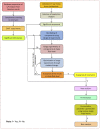Strategies for Fermentation Medium Optimization: An In-Depth Review
- PMID: 28111566
- PMCID: PMC5216682
- DOI: 10.3389/fmicb.2016.02087
Strategies for Fermentation Medium Optimization: An In-Depth Review
Abstract
Optimization of production medium is required to maximize the metabolite yield. This can be achieved by using a wide range of techniques from classical "one-factor-at-a-time" to modern statistical and mathematical techniques, viz. artificial neural network (ANN), genetic algorithm (GA) etc. Every technique comes with its own advantages and disadvantages, and despite drawbacks some techniques are applied to obtain best results. Use of various optimization techniques in combination also provides the desirable results. In this article an attempt has been made to review the currently used media optimization techniques applied during fermentation process of metabolite production. Comparative analysis of the merits and demerits of various conventional as well as modern optimization techniques have been done and logical selection basis for the designing of fermentation medium has been given in the present review. Overall, this review will provide the rationale for the selection of suitable optimization technique for media designing employed during the fermentation process of metabolite production.
Keywords: ANN; OFAT; RSM; genetic algorithm; media optimization.
Figures
Similar articles
-
Optimization of Culture Medium for Maximal Production of Spinosad Using an Artificial Neural Network - Genetic Algorithm Modeling.J Mol Microbiol Biotechnol. 2015;25(4):253-61. doi: 10.1159/000381312. Epub 2015 Jun 30. J Mol Microbiol Biotechnol. 2015. PMID: 26138116
-
Xylanase production from Thermomyces lanuginosus VAPS-24 using low cost agro-industrial residues via hybrid optimization tools and its potential use for saccharification.Bioresour Technol. 2017 Nov;243:1009-1019. doi: 10.1016/j.biortech.2017.07.094. Epub 2017 Jul 19. Bioresour Technol. 2017. PMID: 28764103
-
Medium optimization for pyrroloquinoline quinone (PQQ) production by Methylobacillus sp. zju323 using response surface methodology and artificial neural network-genetic algorithm.Prep Biochem Biotechnol. 2017 Aug 9;47(7):709-719. doi: 10.1080/10826068.2017.1315596. Epub 2017 Apr 27. Prep Biochem Biotechnol. 2017. PMID: 28448745
-
Response surface methodology: A non-conventional statistical tool to maximize the throughput of Streptomyces species biomass and their bioactive metabolites.Crit Rev Microbiol. 2017 Sep;43(5):567-582. doi: 10.1080/1040841X.2016.1271308. Epub 2017 Jan 27. Crit Rev Microbiol. 2017. PMID: 28129718 Review.
-
Optimization and scale up of industrial fermentation processes.Appl Microbiol Biotechnol. 2005 Sep;68(4):425-35. doi: 10.1007/s00253-005-0003-0. Epub 2005 Oct 26. Appl Microbiol Biotechnol. 2005. PMID: 16001256 Review.
Cited by
-
Microbial Squalene: A Sustainable Alternative for the Cosmetics and Pharmaceutical Industry - A Review.Eng Life Sci. 2024 Aug 27;24(10):e202400003. doi: 10.1002/elsc.202400003. eCollection 2024 Oct. Eng Life Sci. 2024. PMID: 39391272 Free PMC article. Review.
-
Production-optimized fermentation of antifungal compounds by bacillus velezensis LZN01 and transcriptome analysis.Microb Biotechnol. 2024 Oct;17(10):e70026. doi: 10.1111/1751-7915.70026. Microb Biotechnol. 2024. PMID: 39415743 Free PMC article.
-
Metabolic Engineering of Microorganisms to Produce Pyruvate and Derived Compounds.Molecules. 2023 Feb 2;28(3):1418. doi: 10.3390/molecules28031418. Molecules. 2023. PMID: 36771084 Free PMC article. Review.
-
Effect of Culture Conditions of Lophocereus marginatus Endophytic Fungi on Yield and Anticancer and Antioxidant Activities.Int J Environ Res Public Health. 2023 Feb 23;20(5):3948. doi: 10.3390/ijerph20053948. Int J Environ Res Public Health. 2023. PMID: 36900961 Free PMC article.
-
RSM-GA Based Optimization of Bacterial PHA Production and In Silico Modulation of Citrate Synthase for Enhancing PHA Production.Biomolecules. 2019 Dec 12;9(12):872. doi: 10.3390/biom9120872. Biomolecules. 2019. PMID: 31842491 Free PMC article.
References
-
- Adinarayana K., Ellaiah P. (2002). Response surface optimization of the critical medium components for the production of alkaline protease by a newly isolated Bacillus sp. J. Pharm. Pharm. Sci. 5, 272–278. - PubMed
-
- Aggarwal A., Singh H. (2005). Optimization of machining techniques—a retrospective and literature review. Sadhana 30, 699–711. 10.1007/BF02716704 - DOI
-
- Baishan F., Hongwen C., Xiaolan X., Ning W., Zongding H. (2003). Using genetic algorithms coupling neural networks in a study of xylitol production: medium optimization. Process Biochem. 38, 979–985. 10.1016/S0032-9592(02)00094-8 - DOI
-
- Banga J., Praveen V., Singh V., Tripathi C., Bihari V. (2008). Studies on medium optimization for the production of antifungal and antibacterial antibiotics from a bioactive soil actinomycete. Med. Chem. Res. 17, 425–436. 10.1007/s00044-007-9077-9 - DOI
Publication types
LinkOut - more resources
Full Text Sources
Other Literature Sources




